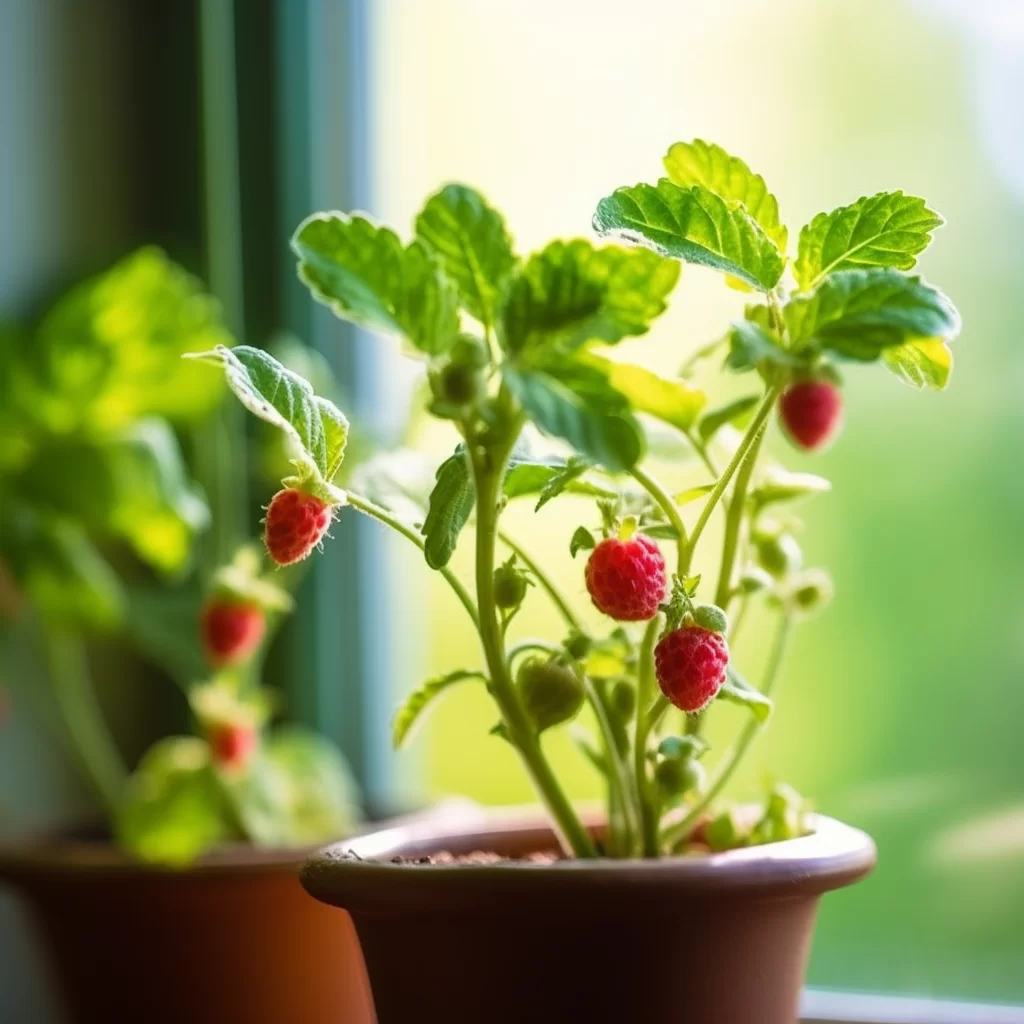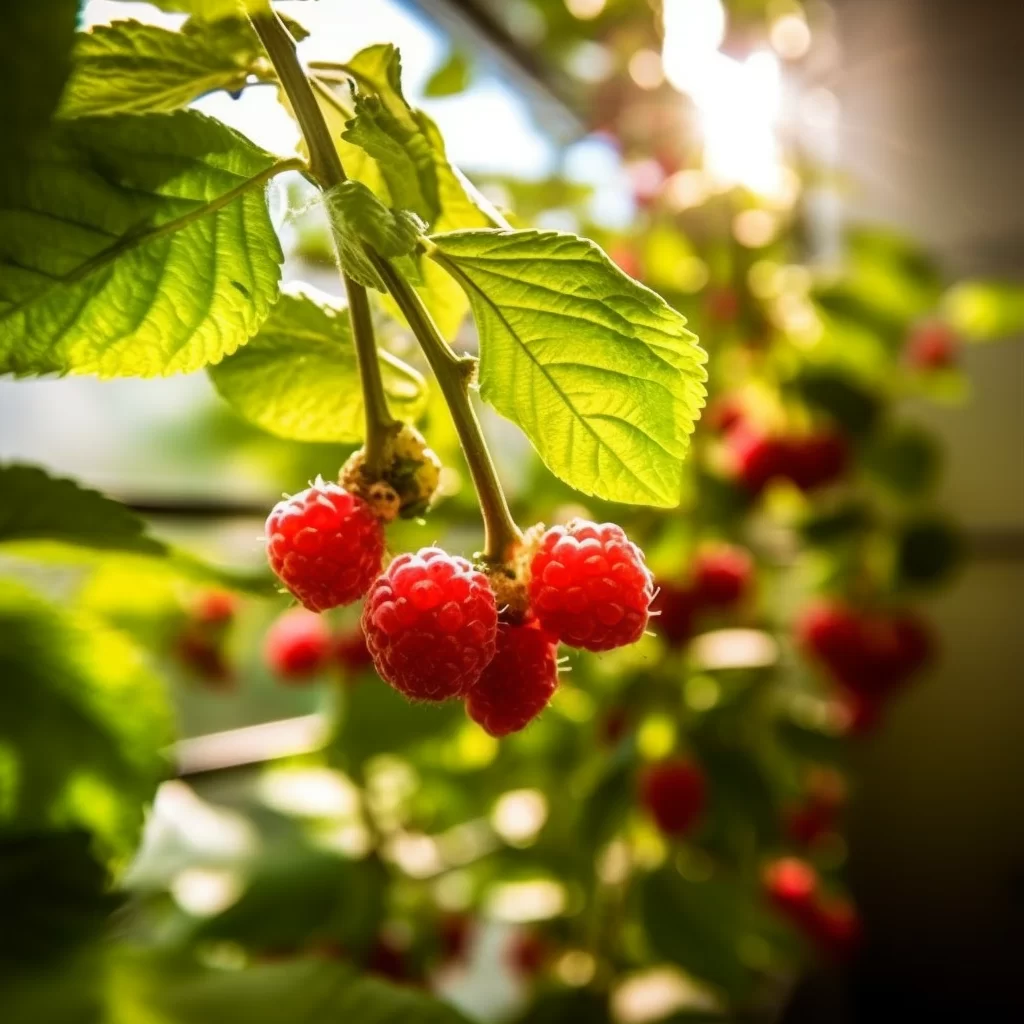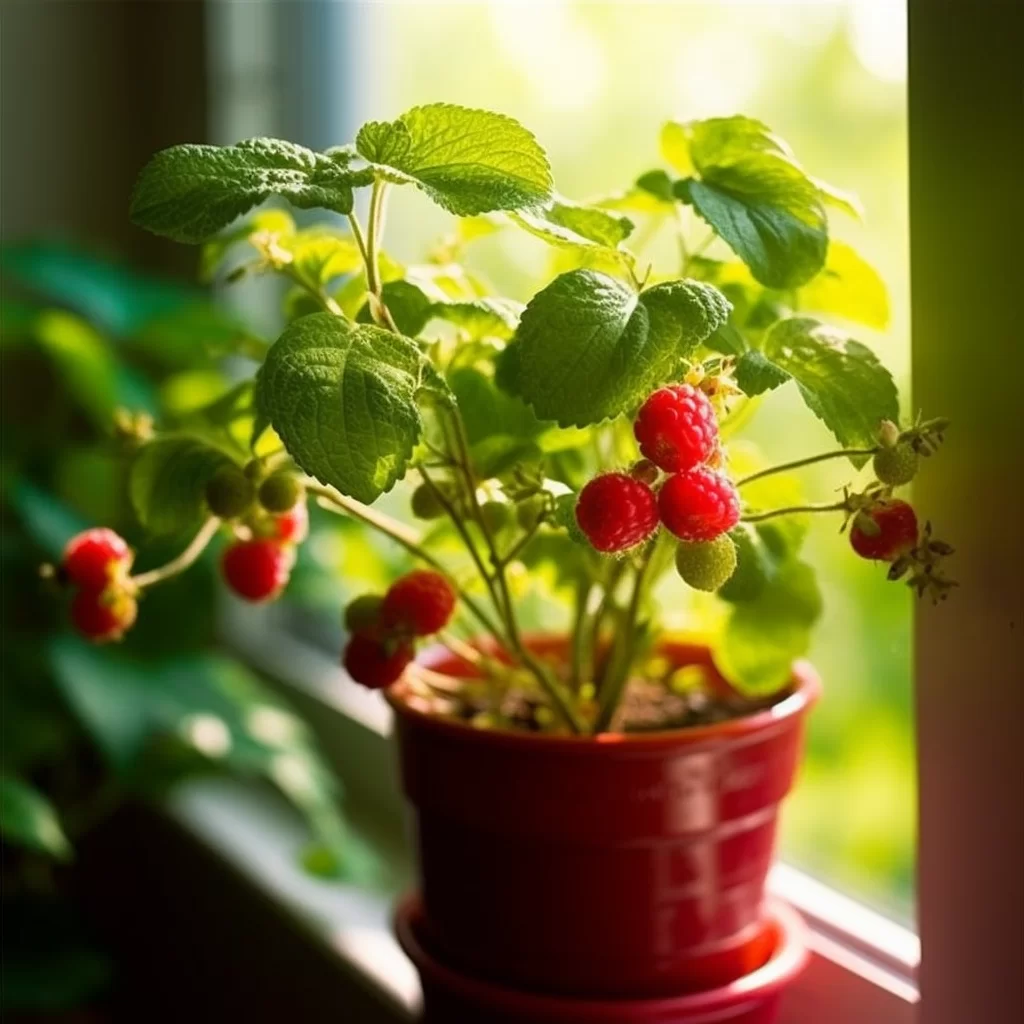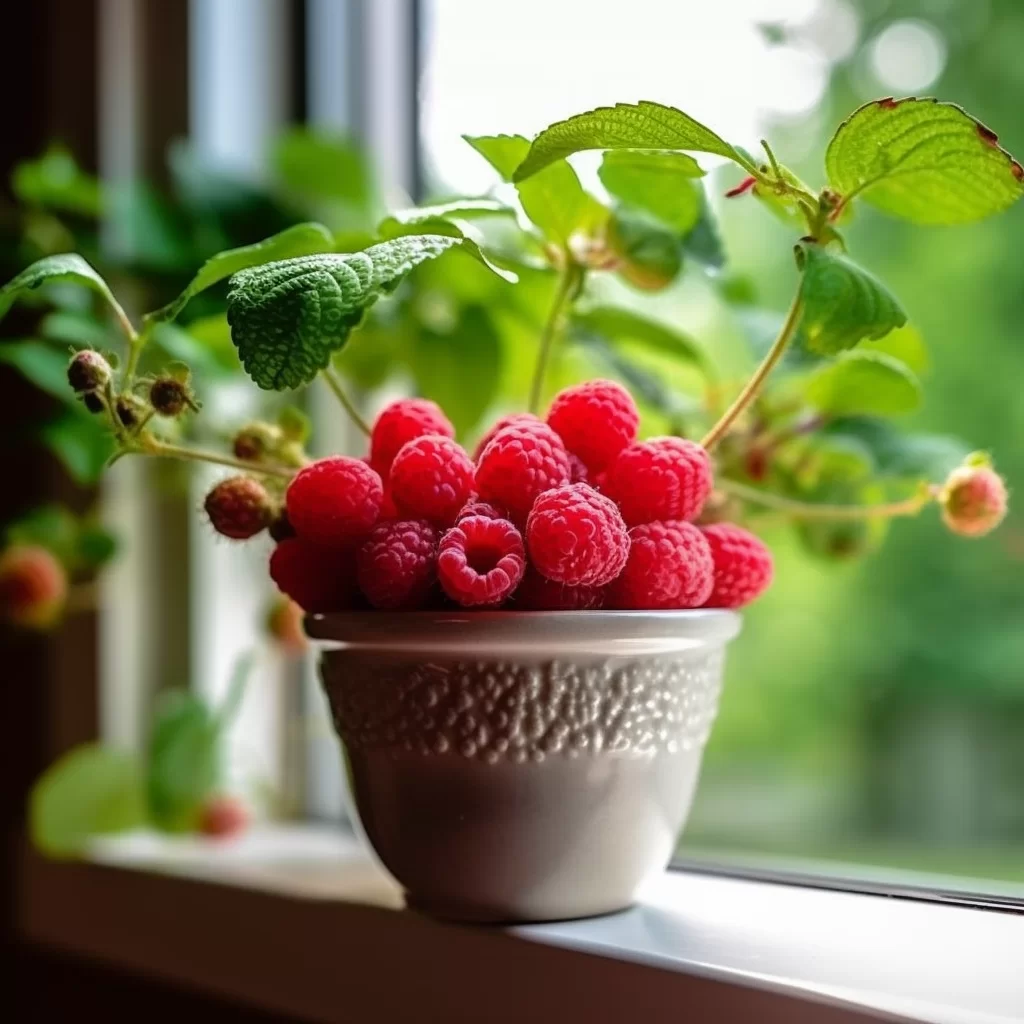Story of Day :
Contents
The Raspberry Shortcake Plant: A Complete Guide and Care Tips
If you’re hoping to add a beautiful and tasty plant to your garden, the raspberry shortcake should be at the top of your list.
This variety is perfect for those looking for an easy-to-grow plant that produces sweet and juicy berries.
The great thing about this particular type of raspberry is that it’s compact, only growing up to 2-3 feet tall and wide.
This little beauty is ideal for small spaces such as balconies or patios.
In this article, we’ll provide you with all the information you need to know about caring for and growing this delicious fruit.It’s incredibly easy to care for raspberry shortcake plants which makes them an excellent choice even if you’re new to gardening.
Not only will these plants add beauty to your space with their lush foliage but they’ll also produce plenty of yummy fruit throughout summer months.
One advantage you get from having raspberries in a compact form like this is that they can easily be grown in containers – making them ideal for small spaces like apartment balconies or tiny backyards where space is limited.
With just a bit of sun, water, fertilizer, and pruning; any gardener can achieve success with raspberry shortcake plants!
Choosing a Location
To start cultivating raspberry shortcake plants, the initial step is finding a suitable spot for them.
These plants thrive in areas that receive full sunlight for a minimum of six hours daily.
However, they can also tolerate partial shade to some extent.
It’s crucial to ensure the selected location has access to sufficient light as too much shade can hinder fruit production. Raspberry shortcake plants require plenty of sunshine and warmth to grow optimally and produce delectable fruits.
Raspberry shortcake plants require plenty of sunshine and warmth to grow optimally and produce delectable fruits.
While they’re adaptable, it’s essential not to overdo it with shade as it could impact their yield negatively.
Therefore, when looking for an ideal site to plant these raspberries, consider areas that get ample sunlight per day and provide enough space for them to grow undisturbedly.
When it comes to gardening, soil is one of the most important factors that contributes to the success of your plants.
A crucial aspect of soil health is its drainage capacity, which directly impacts the growth and development of your garden.
For this reason, it’s vital to choose a well-draining soil that can provide adequate water retention while allowing excess moisture to drain away easily.
Additionally, incorporating organic matter such as compost or aged manure into your soil can significantly improve its fertility and structure.
However, if you are dealing with heavy clay or sandy soils that are prone to waterlogging or droughts respectively, it’s best to amend them with compost before planting anything.In summary, selecting the right type of soil for your garden can make all the difference in how well your plants thrive.
A healthy and well-draining soil that is rich in organic matter allows for better root development and nutrient uptake by plants while minimizing issues like waterlogging or nutrient deficiency in plant growth.
So before you start planting anything in your garden bed or container, be sure to assess the quality of your current soil and consider amending it with compost if necessary – this will help ensure a fruitful growing season ahead!
- Choose a sunny spot in your garden
- Select well-draining soil rich in organic matter
- Amend heavy clay or sandy soils with compost before planting
 Planting Raspberry Shortcake Plants can be a great addition to your garden.
Planting Raspberry Shortcake Plants can be a great addition to your garden.
These plants are a dwarf variety of raspberry that grow up to two to three feet tall, making them perfect for small spaces or container gardening.
The Raspberry Shortcake is also thornless, which makes harvesting easy and pain-free.To plant Raspberry Shortcake Plants, choose a location with well-drained soil and full sun exposure.
Dig a hole twice as wide as the root ball and deep enough so that the top of the root ball is level with the ground surface.
Add compost or fertilizer to enrich the soil before planting.
Water thoroughly after planting, and then water regularly throughout the growing season.
By mid-summer, your Raspberry Shortcake Plants should begin fruiting deliciously sweet berries that are perfect for snacking or baking into pies.Overall, planting Raspberry Shortcake Plants is an excellent choice if you want fresh raspberries in your backyard without taking up too much space or having to deal with thorns during harvest time!
Raspberry shortcake plants are a great addition to any garden and can be easily propagated from cuttings.
This process involves taking cuttings from existing plants during the dormant season, which is typically between late fall and early spring.
With the right care and attention, these cuttings will develop into new raspberry shortcake plants that are just as healthy and vigorous as their parent plant.
If you’re not up for propagating your own raspberry shortcake plants, you can always purchase established ones from nurseries or online stores.
With this option, you’ll have a ready-to-go plant that’s already established and ready to start producing delicious raspberries. Whether you choose to propagate your own raspberry shortcake plant or buy an established one, there are plenty of benefits to enjoy.
Whether you choose to propagate your own raspberry shortcake plant or buy an established one, there are plenty of benefits to enjoy.
Not only do they produce sweet, juicy raspberries that are perfect for snacking on straight off the bush or adding to recipes like pies and jams but they’re also relatively easy to grow once established.
These low-maintenance shrubs don’t require a lot of fussing over but still deliver plenty of fruit each year with proper care.
So if you’re looking for a tasty addition to your garden or backyard space, consider adding some raspberry shortcake plants today!When you plant raspberries from cuttings, it is important to follow a few key steps to ensure the success of your new plants.
First, select healthy and disease-free cuttings from an established raspberry bush.
Next, prepare a well-draining soil mixture and make sure the planting area receives enough sunlight for optimal growth.
Before planting the cuttings, remove any leaves or buds from the lower portion of the stem to promote root development.
Then, place each cutting into a hole in the soil and cover with a light layer of mulch to retain moisture.It is important to keep in mind that it may take some time for your raspberry cuttings to establish roots and begin producing fruit.
However, with proper care such as regular watering and occasional fertilizer applications, you can expect bountiful harvests in future growing seasons.
Additionally, pruning your raspberry bushes annually will help promote new growth and prevent overcrowding which can lead to disease or pest problems.
By following these guidelines when planting raspberries from cuttings, you can enjoy fresh berries straight from your own backyard!
- Cut off 6-inch long sections of branches without leaves using pruning shears.
- Dip each cutting into rooting hormone powder.
- Pot them up into containers filled with a well-draining, nutrient-rich potting mix.
- Water the cuttings thoroughly and place them in a warm, bright location away from direct sunlight.
 If you’re planning to grow raspberries in your garden, one of the best ways to start is by planting established raspberry plants.
If you’re planning to grow raspberries in your garden, one of the best ways to start is by planting established raspberry plants.
These plants are grown from cuttings or suckers and are generally more hardy than those grown from seeds.
Before planting, make sure to choose a sunny spot with well-draining soil.
You’ll want to dig holes that are slightly larger than the root ball of the plant and backfill with compost or well-rotted manure.
Water thoroughly after planting, and keep the soil moist but not waterlogged as your raspberry plant establishes itself.Once your raspberry plant is established, it’s important to prune regularly for optimal growth and fruit production.
Remove any dead or diseased canes in late winter or early spring and thin out any overcrowded canes.
Raspberry plants also benefit from regular fertilization throughout the growing season, so consider adding a balanced fertilizer every 4-6 weeks during peak growing months.
With proper care, you should be able to enjoy delicious raspberries for years to come!
- Dig a hole twice as wide as the plant’s root ball.
- Place the plant in the hole at the same depth as it was in its container or nursery bed.
- Fill in around it with soil and water well to eliminate air pockets around its roots.
Caring for Raspberry Shortcake Plants
Once raspberry shortcake plants are established, they can largely take care of themselves with very little maintenance required.
However, this does not mean that they can be entirely neglected.
To achieve the best possible growth and fruit production, raspberry shortcake plants still require regular attention from gardeners.
This includes routine watering and occasional fertilization to ensure that the soil remains rich in nutrients, as well as pruning to keep the plant healthy and free from disease.
By providing these basic levels of care for raspberry shortcake plants, gardeners can enjoy a bountiful crop of delicious raspberries with minimal effort.While raspberry shortcake plants may be easy to maintain once established, it is important to remember that they still require some level of ongoing care in order to thrive.
This involves keeping a close eye on their progress throughout the growing season and making adjustments as needed based on factors such as weather conditions or pests.
Additionally, regular monitoring of soil moisture levels is crucial for ensuring proper growth and fruit production.
Overall, raspberry shortcake plants offer an excellent option for home gardeners who want a low-maintenance but highly rewarding addition to their backyard landscaping efforts – just be sure not to neglect them completely!
Irrigation:
Raspberry shortcake plants need regular watering to keep their roots moist but not soggy.
- Water deeply every week during hot, dry weather conditions.
- Avoid overhead watering since it can cause fungal diseases like powdery mildew.
Fertilization:
To promote healthy growth and fruit production, fertilize your raspberry shortcake plants annually using balanced organic fertilizer such as fish emulsion or compost tea before spring growth begins.
- Fertilize once every year before spring growth begins with an organic fish emulsion or compost tea fertilizer.
When it comes to gardening, pests and diseases can be a real headache.
Pests like aphids, snails, and slugs can munch on your plants and leave them looking less than desirable.
Diseases like powdery mildew or root rot can quickly spread throughout your garden and cause serious damage.
But don’t worry! There are plenty of ways to prevent and treat these issues.
You can use natural remedies like neem oil or introduce beneficial insects like ladybugs to control pests.
For diseases, make sure your plants are getting enough sunlight and air circulation, as this will help prevent moisture buildup which attracts disease-causing organisms.
And always remember – prevention is key! Keep an eye out for any signs of trouble in your garden so you can catch issues early before they become a major problem.It’s important to note that some pests and diseases may be unavoidable in certain climates or conditions, but taking proactive measures will greatly reduce their impact on your garden’s overall health.
Regularly inspecting your plants for any signs of trouble will help you identify problems early on so that you can take action immediately if necessary.
By following good gardening practices such as proper watering techniques and adequate spacing between plants, you’ll create an environment where pests and diseases have less opportunity to thrive.
Remember that a healthy garden is all about balance – keeping the soil nutrient-rich while minimizing the presence of harmful bugs or fungi will ensure that your plants have everything they need to grow strong all season long!
Raspberry shortcake plants are delicious and nutritious, but unfortunately they are not immune to insect infestations.
They can fall prey to a variety of pests such as the notorious aphids, spider mites, and Japanese beetles.
These pests can cause extensive damage to the plant’s foliage and greatly reduce its fruit production.
It is therefore crucial for gardeners and farmers alike to take proactive measures in controlling these pesky bugs.The good news is that there are ways to control these insects without resorting to harmful chemicals that can harm humans and other beneficial insects such as bees.
One way is through natural predators like ladybugs or lacewings which feed on aphids or releasing parasitic wasps that attack spider mites.
Another option is using organic sprays made from natural ingredients like neem oil or garlic spray that repel a wide range of insect pests without harming the environment.
By employing these methods, farmers can ensure healthy crops while preserving the ecosystem for future generations.
- Spray your raspberries with insecticidal soap or neem oil if you notice any signs of pest infestations.
Raspberries are not immune to fungal infections, and some of the most common ones include powdery mildew and botrytis blight.
These diseases can be quite damaging to raspberry plants, leading to reduced yields and even plant death in severe cases.
To protect your raspberries from these nasty fungi, it is important to take preventive measures.
This may include using fungicides, practicing proper sanitation techniques, and ensuring adequate spacing between plants for good air circulation.Powdery mildew is a particularly common problem that can cause a white powdery coating on leaves and stems of raspberry plants.
Botrytis blight, on the other hand, causes grayish-brown growths on stems or fruit clusters that can quickly spread throughout the plant if left unchecked.
By taking steps to prevent these fungal infections early on, you can help ensure healthy raspberry plants with plentiful yields of juicy berries each season.
- Ensure proper air circulation around your plants by spacing them 2-3 feet apart.
- Remove any infected plant parts and dispose of them immediately to prevent further spread of the disease.
Raspberries are a popular fruit that is often harvested during the summer months.
The process of harvesting raspberries involves carefully picking ripe berries from the plant.
It is important to only pick the berries that are fully ripe and have turned to their characteristic deep red color.
This ensures that they will be sweet and flavorful.To harvest raspberries, it is recommended to wear protective clothing such as gloves and long sleeves, as raspberry plants can have prickly thorns.
The best time to harvest raspberries is in the morning when they are at their freshest.
Once picked, raspberries should be handled gently and stored in a cool place until ready to eat or use in recipes such as jams or desserts.Overall, harvesting raspberries requires patience and attention to detail but can ultimately lead to a delicious reward for those who take on this task.
The raspberry shortcake plant is a popular fruit-producing shrub that typically yields its juicy berries in the height of summer, between July and August.
You’ll know when the berries are ripe for picking as they gradually change from green to a bright red hue, becoming delightfully soft and tender to the touch.
Each year, gardeners eagerly anticipate the arrival of these sweet treats which make for an excellent addition to any dessert or snack.For those who enjoy fresh produce straight from their own garden, growing raspberry shortcake plants can be both simple and rewarding.
With just a little bit of care and attention, you can soon enjoy an abundance of plump berries that will be perfect for snacking on throughout the warm summer months.
Simply keep an eye on your plant as it begins to blossom in early springtime, and watch with excitement as your crop ripens into deliciously juicy fruits by midsummer.
- Pick ripe raspberries carefully using your fingers or pruning shears.
In a nutshell, the summary section provides an overview of the main points covered in a piece of writing.
It gives readers a quick snapshot of what to expect from the rest of the text and helps them decide whether they want to continue reading further or not.
A well-crafted summary is concise, precise, and informative, presenting key ideas without unnecessary details or fluff.
Whether it’s an academic paper, news article, or book review, having a solid summary can be incredibly beneficial for both writers and readers alike.Furthermore, summaries can serve as useful tools for note-taking and studying purposes.
By condensing complex information into digestible chunks that capture the essence of what’s being communicated, individuals can improve their retention and comprehension of material.
Additionally, summaries can help writers clarify their own thinking about a topic by forcing them to distill their ideas down to their most essential components.
Overall, summaries provide valuable insights into any given content while also saving time by allowing people to quickly absorb crucial information without getting bogged down in extraneous details.
If you’re a gardening enthusiast or just starting out, raspberry shortcake plants are a fantastic choice to grow.
Not only do they look beautiful, but these plants are easy to take care of and produce mouth-watering fruits that everybody can enjoy.
As long as you plant them in a sunny area with well-draining soil and provide them with regular watering (but be sure not to water from above), your raspberry shortcake plants will thrive! Remember to add organic matter annually for fertilization and keep an eye on pests and diseases that could harm your harvest.Growing raspberries in your garden can be an incredibly rewarding experience.
With raspberry shortcake plants, you don’t need a lot of gardening know-how or expertise to achieve success.
All it takes is some TLC – tender loving care – by following some basic care instructions such as providing sunlight exposure, proper drainage, periodic feeding with organic matter, pest control measures and avoiding overhead watering that could lead to fungal growths on the leaves.
By taking these simple steps, you’ll be able to bask in the satisfaction of having ripe raspberries ready for picking right at home!